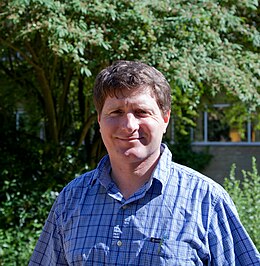Ian Agol
| Naissance | |
|---|---|
| Nationalité | |
| Formation |
Université de Californie à San Diego The College Preparatory School (en) |
| Activités |
| A travaillé pour | |
|---|---|
| Membre de | |
| Maître | |
| Directeur de thèse | |
| Site web | |
| Distinctions |
Ian Agol (né le ) est un mathématicien américain qui travaille principalement sur la topologie de 3-variété[1].
Formation et carrière
[modifier | modifier le code]Agol obtient son doctorat en 1998 à l'Université de Californie à San Diego sous la supervision de Michael Freedman avec une thèse intitulée Topology of Hyperbolic 3-Manifolds[2]. Il est professeur à l'Université de Californie à Berkeley[3] et ancien professeur à l'Université de l'Illinois à Chicago[4].
Contributions
[modifier | modifier le code]En 2004, Agol prouve la conjecture de Marden (en), une conjecture énoncée par Albert Marden[5]. Elle énonce qu'une 3-variété hyperbolique dont le groupe fondamental est finiment engendré est homéomorphe à l'intérieur d'une 3-variété compacte. La conjecture a été également prouvée indépendamment par Danny Calegari et David Gabai, et implique la conjecture d'Ahlfors (en).
En 2012, il a annoncé une preuve de la conjecture de Haken virtuelle (en). Elle affirme que toute 3-variété asphérique est finiment couverte par une variété de Haken.
Prix et distinctions
[modifier | modifier le code]Ian Agol reçoit avec Calegari et Gabai le Clay Research Award en 2009 pour sa preuve de la conjecture de Marden.
En 2005, Agol bénéficie d'une Bourse Guggenheim[6]. En 2006 il est conférencier invité au congrès international des mathématiciens à Madrid avec une conférence intitulée « Finiteness of arithmetic Kleinian reflection groups ». Il donne ensuite une conférence plénière au congrès de 2014 à Séoul intitulée « Virtual properties of 3-manifolds ».
En 2012, il est lauréat du prix Berwick sénior. En 2012, il est devenu fellow de l'American Mathematical Society[7].
En 2013, Agol a reçu le prix Oswald-Veblen en géométrie, avec Daniel Wise[8] pour leur théorie des complexes cubiques spéciaux et pour avoir démontré la séparabilité des sous-groupes d'une large classe de groupes (for the theory of special cube complexes and his establishment of subgroup separability for a wide class of groups).
En 2015, il a reçu le Breakthrough Prize in Mathematics 2016 « pour ses spectaculaires contributions à la topologie en basses dimensions et la théorie géométrique des groupes, y compris les travaux sur les solutions des conjectures tameness, virtuelle Haken et virtuel fibering »[9].
En 2016, il a été élu à l'Académie nationale des sciences[10].
Publications
[modifier | modifier le code]- (en) Ian Agol, « The virtual Haken conjecture. With an appendix by Agol, Daniel Groves, and Jason Manning », Doc. Math., vol. 18, , p. 1045-1087 (MR 3104553)ArXiv.
- Bounds on exceptional Dehn filling, Geom. Topol. 4 (2000), 431–449. ArXiv
- avec D. Long, A. Reid: The Bianchi groups are separable on geometrically finite subgroups, Ann. of Math. (2) 153 (2001), no. 3, 599–621. ArXiv
- Tameness of hyperbolic 3-manifolds, Preprint 2004. ArXiv
- avec P. Storm, W. Thurston: Lower bounds on volumes of hyperbolic Haken 3-manifolds. With an appendix by Nathan Dunfield, J. Amer. Math. Soc. 20 (2007), no. 4, 1053–1077. ArXiv
- Criteria for virtual fibering, J. Topol. 1 (2008), no. 2, 269–284. ArXiv
- avec D. Groves, J. F. Manning: Residual finiteness, QCERF and fillings of hyperbolic groups, Geometry and Topology, 13 (2009), no. 2, 1043–1073. ArXiv
- avec Y.Liu: Presentation length and Simon's conjecture, J. Amer. Math. Soc. 25 (2012), no. 1, 151–187. ArXiv
- avec D. Groves, J. F. Manning: An alternate proof of Wise's malnormal special quotient theorem. Forum Math. Pi 4 (2016), e1, 54 pp
Vie personnelle
[modifier | modifier le code]Son frère jumeau, Eric Agol (de)[11],[12] est professeur d'astronomie à l'Université de Washington à Seattle[13].
Références
[modifier | modifier le code]- Dana Mackenzie et Barry Cipra, What's happening in the mathematical sciences, American Mathematical Society, , 15–16 p. (ISBN 978-0-8218-3585-2, lire en ligne)
- (en) « Ian Agol », sur le site du Mathematics Genealogy Project.
- « Ian Agol », University of California, Berkeley Department of Mathematics (consulté le )
- « Ian Agol », University of Illinois at Chicago (consulté le )
- « Clay Research Award » [archive du ], Clay Mathematics Institute (consulté le )
- « Ian Agol – Guggenheim Fellows Finder », John Simon Guggenheim Memorial Foundation (consulté le )
- List of Fellows of the American Mathematical Society, retrieved 2012-11-03.
- Joint Mathematics Meetings Prize Booklet: January 2013 Prizes and Awards: Oswald Veblen Prize in Geometry, pp. 14–18
- « Breakthrough Prizes Give Top Scientists the Rock Star Treatment »,
- National Academy of Sciences Members and Foreign Associates Elected, National Academy of Sciences, (lire en ligne).
- « Obituaries – Alan Agol », Visalia Times-Delta, , p. C2 (lire en ligne)
- « Alan Agol », Marin Independent Journal, (lire en ligne)
- « Eric Agol », University of Washington Department of Astronomy (consulté le )
Liens externes
[modifier | modifier le code]
- Site officiel
- Ressources relatives à la recherche :
- publications indexées par Google Scholar
Text is available under the CC BY-SA 4.0 license; additional terms may apply.
Images, videos and audio are available under their respective licenses.

